

National History Bee. Subjects - Extreme Weather. No matter where you live in the world, weather is something that you are exposed to every single day.

Even though weather occurs all around the world, the region you live in can have a different natural phenomenon than another geographical locations. For example, if you live in the Midwest of the United States, it isn't very likely that you'll get hurricanes but you may be very familiar with tornados. Why is it sunny most of the year in some places and rainy in other places? What causes tsunamis and earthquakes? Learning more about what causes these forces of nature can help us to be better prepared when they happen. Even though weather is different all around the world, our weather systems are all very interconnected. Articles Events Activities Cool Jobs Advocacy.
Blogfolios: The Glue that Can Hold it All Together in Learning. Digital Portfolios are so much more than a digital versions of a paper portfolio, a folder sent home at the end of the week, semester or year or an online version of someone’s writing journal.
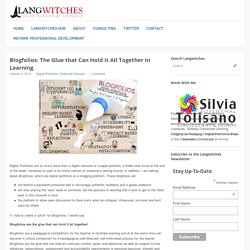
In addition, I am talking about Blogfolios, which are digital portfolios on a blogging platform. These blogfolios are: not behind a password protected wall to encourage authentic feedback and a global audiencenot only sharing the “best” work of someone, but the process of learning that it took to get to the “best” work in this moment in timethe platform to allow open discussion to have one’s work be critiqued, influenced, re-mixed and built upon by others If I had to create a “pitch” for Blogfolios, I would say: Blogfolios are the glue that can hold it all together! PBS LearningMedia. The Science Spot. WeeklyChecklistExamplePresentations.pdf. Big History Project.
National History Day in Wisconsin. 62 School Project Ideas. Are you a teacher, parent, or student looking for a creative project idea?
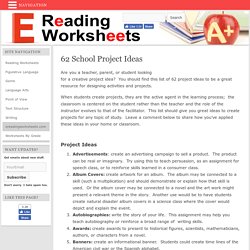
You should find this list of 62 project ideas to be a great resource for designing activities and projects. When students create projects, they are the active agent in the learning process; the classroom is centered on the student rather than the teacher and the role of the instructor evolves to that of the facilitator. Project Based Learning. Sun Prairie PL 2015. 60.5. Why the 21st Century Classroom May Remind You of Starbucks. It’s been my dream to make my 2nd grade classroom look more like a “Starbucks for kids”, and less like, well, a classroom.
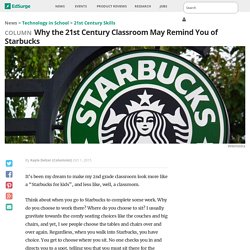
Think about when you go to Starbucks to complete some work. Welcome to Maker Camp. How UDL can get you to personalized learning. DreamBox Learning Math for Middle School - DreamBox Learning. Home and School Systems. Nelson and Pade, Inc.®’s Home Food Production systems use the same science-based design, component ratios and water flow dynamics as our commercial systems.
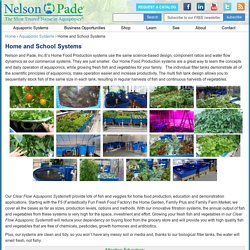
They are just smaller. Our Home Food Production systems are a great way to learn the concepts and daily operation of aquaponics, while growing fresh fish and vegetables for your family. The individual filter tanks demonstrate all of the scientific principles of aquaponics, make operation easier and increase productivity. The multi fish tank design allows you to sequentially stock fish of the same size in each tank, resulting in regular harvests of fish and continuous harvests of vegetables. Our Clear Flow Aquaponic Systems® provide lots of fish and veggies for home food production, education and demonstration applications. Plus, our systems are clean and tidy, so you won’t have any messy soil or media and, thanks to our biological filter tanks, the water will smell fresh, not fishy. Four Great Systems for Home Food Production: Curiosity Machine – Hands-on Science Projects. The Scientific Teacher. Earth. Imagine Cup Earth is a new contest for students ages 6-18 in which you’ll use computer programming to create a game, simulation, or story inspired by the kinds of earth science that NASA and other researchers do every day. 18 winning students will win prizes totaling $36,000!
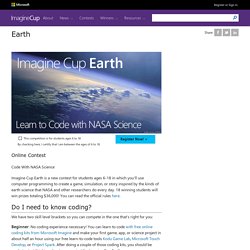
You can read the official rules here. Do I need to know coding? We have two skill level brackets so you can compete in the one that’s right for you: Beginner: No coding experience necessary! You can learn to code with free online coding kits from Microsoft Imagine and make your first game, app, or science project in about half an hour using our free learn-to-code tools Kodu Game Lab, Microsoft Touch Develop, or Project Spark. GK-12 : STEM Activities and Resources for K-12 Teachers and Students.
For All Grades (K-12) From AAAS.
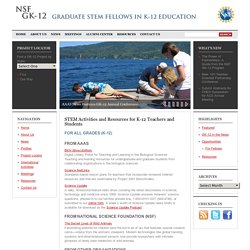
National History Day. Environmental Test Lab Kit. Porosity of Soils and Water Flow Lab. LaMotte Soil NPK Test Kit. Backpack Lab · Soil quality education kit. WCBM Partnership Program. Home ...
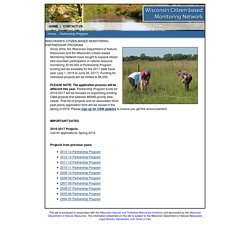
Partnership Program Since 2004, the Wisconsin Department of Natural Resources and the Wisconsin Citizen-based Monitoring Network have sought to expand citizen and volunteer participation in natural resource monitoring. $100,000 of Partnership Program funding will be available for the 2017 state fiscal year (July 1, 2016 to June 20, 2017). Funding for individual projects will be limited to $5,000. PLEASE NOTE: The application process will be different this year. Citizen-based Monitoring Partnership Program. Since 2004, the Wisconsin Department of Natural Resources and Wisconsin's "Citizen-Based Monitoring Partnership Program" have sought to expand citizen and volunteer participation in natural resource monitoring by providing funding and assistance with high priority projects.
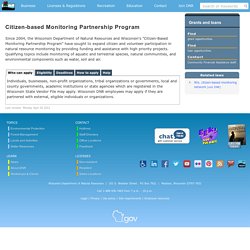
Qualifying topics include monitoring of aquatic and terrestrial species, natural communities, and environmental components such as water, soil and air. Who can apply Individuals, businesses, non-profit organizations, tribal organizations or governments, local and county governments, academic institutions or state agencies which are registered in the Wisconsin State Vendor File may apply. Wisconsin DNR employees may apply if they are partnered with external, eligible individuals or organizations. Eligibility Eligible projects Ineligible items. Technology Programs – Upham Woods Outdoor Learning Center. Program Overview and Goals The Digital Observation Technology Skills (DOTS) program is an outdoor environmental education lesson that uses modern mobile technology tools to connect today’s students to the outdoors in new and innovative ways.

This inquiry-based lesson navigates the basics of the scientific method and focuses on the importance of good scientific communication and sharing discoveries with others. Students work in groups to test simple hypotheses from the environmental and ecological differences across the local landscape using data and observations collected in the field.
Participants use the technology tools found in the DOTS kits to make observations, take measurements, explore the micro and macro details of their environment, and learn how to embrace their inner scientists. David McCandless: The beauty of data visualization. Smithsonian Science. Smithsonian Science. What happens when ocean currents and air masses interact? Find out in Weather Lab! Take on the role of a meteorologist by predicting spring weather and how people should dress for it in particular regions of the United States. Weather Lab is a tool to help visualize how North America’s weather is formed. This lab is designed to model the complex interactions between air masses and ocean currents, but like all models it represents probable outcomes.